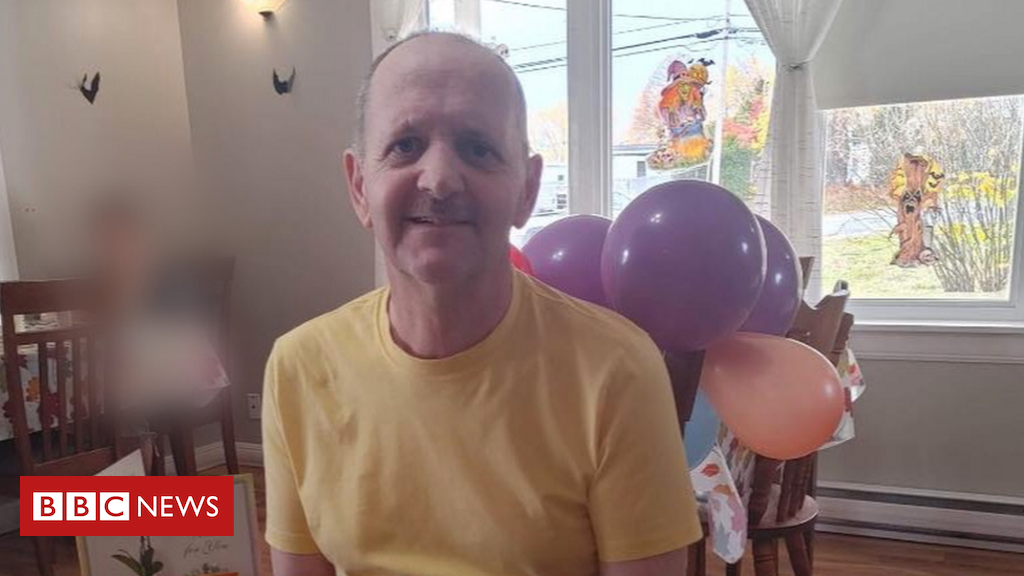- Jessica Murphy
- From BBC News in Toronto
In audio: The mysterious brain disease that intrigues doctors in Canada
Doctors in Canada have faced patients with symptoms similar to those of Creutzfeldt-Jakob disease, a rare and deadly disease that attacks the brain. But when they decided to investigate the evil in more detail, what they found baffled them.
Nearly two years ago, Roger Ellis collapsed in his home from a seizure on his 40th wedding anniversary.
In his early 60s, Ellis, who was born and raised in the bucolic Acadian Peninsula of New Brunswick, was a healthy person. He was enjoying his retirement after decades of work as an industrial mechanic.
His son, Steve Ellis, says that after that fateful day, his father’s health declined rapidly.
“He had delusions, hallucinations, weight loss, aggression, repetitive speech,” he says.
“At one point he couldn’t even walk. Within three months, doctors said they believed he was dying, but no one knew why.”
Credit, Courtesy of Steve Ellis
Roger Ellis (right) started showing symptoms of the disease in 2019, says Steve Ellis (left)
Roger Ellis’ doctors initially suspected Creutzfeldt-Jakob disease (CJD). It is a disease caused by proteins called prions. This rare and fatal degenerative brain disease causes patients to experience symptoms such as poor memory, behavioral changes and coordination difficulties.
A well-known category of the disease is called variant CJD, which is associated with the consumption of meat contaminated with mad cow disease. CJD also belongs to a broader category of brain diseases like Alzheimer’s disease, Parkinson’s disease and ALS, in which proteins in the nervous system become deformed.
But Ellis’ CJD test came back negative, as did the barrage of other tests his doctors gave him as they tried to determine the cause of his illness.
His son says the medical team did what they could to ease his father’s many symptoms, but one mystery remained: what was behind Ellis’ worsening condition?
Credit, Getty Images
Moncton is the largest city in the province of New Brunswick
In March this year, Steve Ellis found a possible – albeit partial – answer to his father’s illness.
Radio-Canada, the country’s public broadcaster, obtained a copy of a public health memo sent to medical professionals in the province warning of a group of patients with an unknown degenerative brain disease.
“The first thing I said was, ‘He’s like my dad’,” he recalls.
Roger Ellis is now believed to be one of those affected by the unknown disease and is in the care of neurologist Alier Marrero.
Hospital neurologist Dr. Georges-L-Dumont University Hospital Center in Moncton says doctors first detected the disease in 2015. At the time, there was only one patient – a “isolated and unusual case,” he says.
But since then there have been more patients like the first – enough that doctors can now identify a different “never seen before” condition or syndrome.
The province says it is currently tracking 48 cases, split evenly between men and women, aged 18 to 85. These patients come from the Acadian Peninsula and Moncton regions in New Brunswick. Six people are believed to have died of the disease.
Most of the patients started showing symptoms recently, from 2018, although one is thought to have had symptoms already in 2013.
The neurologist says the symptoms are varied.
At first, behavioral changes such as anxiety, depression, and irritability may occur, in addition to unexplained aches, muscle aches, and spasms in healthy people.
Often, patients develop sleep disturbances – severe insomnia or hypersomnia – and memory problems. There may be language disorders that progress quickly and make it difficult to communicate and keep a conversation flowing, problems such as stuttering or repeating words.
Another symptom is rapid weight loss and muscle wasting, along with visual disturbances and coordination problems and involuntary muscle spasms. Many patients require the assistance of walkers or wheelchairs.
Some develop nightmares or auditory hallucinations upon waking.
Several patients suffered from Capgras syndrome, a psychiatric disorder in which a person believes that a loved one has been replaced by an impostor.
“It’s quite disturbing because, for example, a patient said to his wife: ‘Sorry ma’am, we can’t sleep together, I’m married’ and even when the woman said her name, he replied: ‘You don’t you’re not the real one,” said the doctor.
The Canadian neurologist is leading the investigation into the disease with the help of a team of researchers and the federal public health agency.
Suspected patients undergo screening tests for prions and genetic diseases, panels that look for autoimmune diseases or forms of cancer, and tests to detect viruses, bacteria, fungi, heavy metals and antibodies abnormal.
They are asked about environmental factors, lifestyle, travel, medical history, food and water. They undergo lumbar punctures to test for various infections and disorders.
There is no treatment available for the causes. The only possible treatment is to help relieve the discomfort of some of the symptoms. For now, the theory is that the disease is acquired and not genetic.
“Our first common idea is that there is an acquired toxic element in the environment of this patient that triggers the degenerative changes”, explains the neurologist.
Credit, Getty Images
Roger Ellis lived in the city of Bathurst
Also University of British Columbia neurologist Neil Cashman is one of the researchers trying to unravel the medical mystery.
Although the patients show no signs of prion disease, the cause has not been completely ruled out, he says.
Another theory is chronic exposure to “excitotoxins” such as domoic acid. This toxin has been linked to a food poisoning incident caused by contaminated shellfish in 1987 in the neighboring province of Prince Edward Island.
In addition to gastrointestinal problems, about a third of those affected experience symptoms such as memory loss, dizziness, confusion. Some patients fell into a coma and four died.
Cashman says they are also studying another toxin – beta-methylamino-L-alanine (BMAA) – which has been listed as a risk factor for developing diseases like Alzheimer’s disease and Parkinson’s disease.
Some researchers also believe that this second toxin is linked to a neurodegenerative disease documented in the indigenous population of the United States territory of the island of Guam, in the Pacific, in the mid-20th century, and found in seeds that were part of the diet of the band.
Cashman warns that the current list of theories is “not complete”.
“We have to go back to the beginning, back to square one,” he said. “At this stage, basically, nothing can be ruled out.”
So how many more people can be affected by this disease?
Credit, Courtesy of Steve Ellis
Roger Ellis’ condition has stabilized
Marrero says it’s possible this is a broader phenomenon found outside of the two regions where patients have been identified so far (the Acadian Peninsula, with its fishing communities and sandy beaches , and Moncton, a downtown).
“Are we seeing the tip of the iceberg? Maybe,” he said. “Hopefully we can figure this out quickly to prevent more cases.”
While those living in affected communities are understandably worried, Marrero urges people to “work with hope, not fear. Fear paralyzes.”
Roger Ellis’ condition has stabilized since the initial rapid progression, his son says.
He is in a specialized nursing home and needs help with his daily activities. He still has speech and sleep problems.
Steve Ellis, who runs a Facebook support group for families affected by the disease, is urging the government to commit to being transparent about the disease.
He especially wants to know what made his father sick.
“I know they’re working on it, but how did it go?” he asks.
“As a family, we are aware that he will most likely die of this.”
Have you watched our new videos on Youtube? Subscribe to our channel!

“Freelance communicator. Hardcore web practitioner. Entrepreneur. Total student. Beer ninja.”







